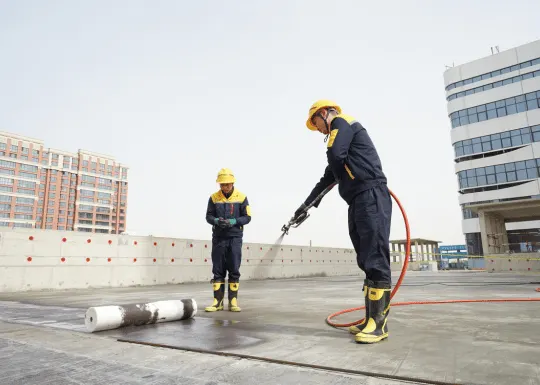All You Need to Know About Top-Rated Waterproofing Companies
Waterproofing is the process of making structures water-resistant so they can withstand exposure to moisture without being damaged. It is a critical aspect of construction and building maintenance, especially in areas prone to heavy rainfall, humidity, or water table fluctuations. Top-rated waterproofing companies specialize in applying sealants, membranes, coatings, and other methods to prevent water intrusion in buildings—especially in basements, rooftops, bathrooms, balconies, and foundations.
Whether you own a residential property or manage a commercial building, waterproofing helps protect the structural integrity of the premises, prevents mold growth, and ensures long-term durability. Over the years, the waterproofing industry has evolved to use more environmentally friendly materials and advanced techniques for better results.
Why Waterproofing Matters Today
Water damage is one of the most common and costly problems faced by property owners. Here’s why waterproofing has become a top priority:
-
Climate Change: With increasing rainfall intensity and unexpected weather patterns, many buildings are more vulnerable to leakage and dampness.
-
Urbanization: High-rise construction and compact urban development demand efficient waterproofing to protect large infrastructure.
-
Health Concerns: Damp environments encourage mold growth, which can lead to respiratory issues and allergies.
-
Asset Protection: Water intrusion can damage electrical systems, wooden structures, insulation, and interiors, leading to expensive repairs.
According to a 2024 report by the International Facility Management Association (IFMA), nearly 65% of building maintenance requests in humid regions were related to water intrusion. Property owners, housing developers, and facility managers now actively seek top-rated waterproofing solutions as a preventative investment rather than a reactive fix.
Recent Trends and Developments (2024–2025)
The waterproofing industry has seen various updates and innovations in the past year:
| Trend/Update | Details |
|---|---|
| Green Waterproofing Products | Companies are offering low-VOC and eco-friendly sealants to meet sustainability goals. |
| Nanotechnology Use | Advanced coatings now use nanotech to create stronger, invisible water barriers. |
| Digital Moisture Sensors | Integration of IoT-based systems to detect leaks early, minimizing repair costs. |
| Increased Demand in Coastal Cities | Cities like Miami, Mumbai, and Manila report a 20% rise in waterproofing contracts. |
| Regulatory Push | Municipalities are pushing mandatory waterproofing codes for new construction permits. |
Laws and Regulatory Framework
Waterproofing regulations vary from country to country, but there are several common standards and policies worth noting:
-
Building Codes: Many countries now require waterproofing as a mandatory component under national building codes. For example, the National Building Code of India mandates waterproofing for all basements and rooftops.
-
Environmental Regulations: Use of chemicals in sealants and coatings must comply with environmental standards like REACH (EU) or EPA (USA) to ensure safe usage.
-
Warranty Laws: Some regions require waterproofing companies to offer minimum warranties (typically 5–10 years) on their services.
-
Insurance Requirements: Commercial properties often need certified waterproofing to qualify for building insurance or to avoid higher premiums.
In 2024, California’s Green Building Standards Code (CALGreen) updated its requirements for waterproofing materials to include higher durability and sustainability benchmarks for new residential buildings.
Helpful Tools and Resources
For homeowners, contractors, and property managers, there are several digital tools and resources available to streamline the waterproofing process:
| Tool/Resource | Purpose |
|---|---|
| Moisture Mapper App | Tracks and monitors indoor humidity and water leakage in real-time. |
| HomeAdvisor / Angi | Platforms to find and review top-rated waterproofing companies. |
| Cost Estimator Calculators | Helps estimate waterproofing project budgets based on area size. |
| Construction Safety Training (OSHA) | Offers waterproofing-specific safety training resources and guides. |
| Waterproofing Material Certifications | Reference databases for checking eco-certified and tested products. |
Frequently Asked Questions (FAQs)
1. What areas of a building need waterproofing the most?
Waterproofing is essential for basements, roofs, terraces, external walls, bathrooms, and water tanks. Any surface exposed to water or moisture regularly is a candidate for waterproofing to prevent damage.
2. How often should waterproofing be redone?
On average, waterproofing systems last 7 to 15 years, depending on the materials used and weather conditions. Periodic inspections are recommended every 3–5 years to detect early signs of failure.
3. Are waterproofing products safe for the environment?
Many companies now use low-VOC (Volatile Organic Compound) materials that are safe for both users and the environment. Look for eco-certified products that meet global safety standards.
4. What’s the difference between damp proofing and waterproofing?
Damp proofing restricts moisture movement through walls, whereas waterproofing blocks water completely. Waterproofing is a more comprehensive solution and suitable for areas in direct contact with water.
5. How do I choose a reliable waterproofing company?
Look for companies with:
-
Valid licenses and certifications
-
Long-standing market presence
-
Clear warranty policies
-
Verified customer reviews
-
Use of certified materials and technologies
Conclusion
Waterproofing is no longer an optional aspect of construction; it is a fundamental requirement for structural safety, long-term maintenance, and occupant health. With advances in technology and a growing awareness of water damage risks, top-rated waterproofing companies are equipped with the tools and expertise to meet modern demands.
From residential projects to large commercial buildings, ensuring effective waterproofing helps avoid costly repairs and supports better building performance. By understanding recent trends, regulations, and available tools, property owners can make informed decisions and protect their investments effectively.
